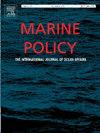Mismatches between the current marine Natura 2000 network and seabird distributions call for enhanced protected areas off metropolitan France
IF 3.7
2区 社会学
Q2 ENVIRONMENTAL STUDIES
引用次数: 0
Abstract
Seabirds are among the most threatened vertebrates, under pressure from fisheries bycatch, climate change, overfishing, and human disturbance. In France, demographic studies have highlighted adult survival as a key factor in population trends, which calls for large-scale marine conservation efforts. In this context, the Natura 2000 policy requires the designation of Special Protection Areas (SPAs) to protect seabirds under the Birds Directive. To assess the completeness of the French marine SPA network, data from aerial, boat, and coastal surveys, as well as tracking devices and distribution models, were collected for 57 seabird taxa. This data collection allowed the EU minimum criteria for a coherent SPA network to be spatially implemented, and the most ecologically valuable areas for seabirds around metropolitan France to be identified and prioritised, and overlaid with the current French SPA network and Marine Important Bird Areas (mIBAs) to identify potential inconsistencies. This analysis revealed seabird hotspots outside the existing ecological network, confirming some insufficiencies for coherent seabird conservation. Although data dependent, this analysis highlighted the limitations of using global proportion coverage to assess network coherence when coverage of biodiversity and abundance hotspots was not achieved. Furthermore, these results summarised the main target areas for policy makers to effectively improve seabird conservation around metropolitan France. In a context of increasing demands for marine spatial planning, improvements in this knowledge, the SPA network and conservation actions are required.
目前的海洋自然2000网络与海鸟分布之间的不匹配要求加强法国大都市附近的保护区
海鸟是最受威胁的脊椎动物之一,受到渔业副渔获物、气候变化、过度捕捞和人类干扰的压力。在法国,人口研究强调,成年人的生存是人口趋势的一个关键因素,这要求大规模的海洋保护工作。在这种情况下,《自然2000》政策要求根据《鸟类指令》指定特别保护区(spa)来保护海鸟。为了评估法国海洋SPA网络的完整性,我们收集了57个海鸟分类群的空中、船只和海岸调查数据,以及跟踪设备和分布模型。这些数据收集使得欧盟在空间上实施了一个连贯的SPA网络的最低标准,并确定了法国大都市周围最具生态价值的海鸟区域,并将其与当前的法国SPA网络和海洋重要鸟类区(mIBAs)重叠,以识别潜在的不一致性。这一分析揭示了现有生态网络之外的海鸟热点,证实了海鸟保护的一些不足之处。尽管依赖于数据,但该分析强调了在生物多样性和丰度热点未覆盖的情况下,使用全球比例覆盖率来评估网络一致性的局限性。此外,这些结果总结了决策者有效改善法国大都市周围海鸟保护的主要目标区域。在对海洋空间规划的需求日益增加的背景下,需要改进这方面的知识,SPA网络和保护行动。
本文章由计算机程序翻译,如有差异,请以英文原文为准。
求助全文
约1分钟内获得全文
求助全文
来源期刊

Marine Policy
Multiple-
CiteScore
7.60
自引率
13.20%
发文量
428
期刊介绍:
Marine Policy is the leading journal of ocean policy studies. It offers researchers, analysts and policy makers a unique combination of analyses in the principal social science disciplines relevant to the formulation of marine policy. Major articles are contributed by specialists in marine affairs, including marine economists and marine resource managers, political scientists, marine scientists, international lawyers, geographers and anthropologists. Drawing on their expertise and research, the journal covers: international, regional and national marine policies; institutional arrangements for the management and regulation of marine activities, including fisheries and shipping; conflict resolution; marine pollution and environment; conservation and use of marine resources. Regular features of Marine Policy include research reports, conference reports and reports on current developments to keep readers up-to-date with the latest developments and research in ocean affairs.
 求助内容:
求助内容: 应助结果提醒方式:
应助结果提醒方式:


